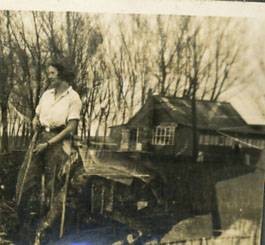
Introduction
Sometime in 2004, a visitor to The Welney Website, Charles Frowd from Sussex, contacted me, Peter Cox, in my capacity then as the Welney Webmaster. His mother and her family holidayed somewhere near Welney in the 1930s, and he e-mailed a copy of a faded sepia photograph of a bungalow they stayed in somewhere on the banks of The Old Bedford River. He wondered whether I knew its location, and if it still existed. I didn't, but luckily I knew a man who did.What I learned subsequently was how a piece of marshy Cambridgeshire fen farmland just a few miles from my home at Tipps End became world famous as the site in the late 1830s of a great social experiment, a Utopian Dream - The Colony at Manea Fen. Sadly, it didn't last, but its records did and several academic papers have been published about it which you can read on other pages. My task has been - and still is - to trace and record the changes in the occupants and use of the land in the years since.
The events that ultimately led to the establishment of The Colony started in the years following the Napoleonic Wars. It includes the problems caused by troops returning home; of social injustice, the Littleport Riots (at the village a few miles away) and the infamous trial that followed; the Poor Laws and separation of families in Workhouses; the idea of a "new moral world"; and the establishment of organised socialist communes.
Whilst researching, I learned of brick-making and pike fishing. Amazingly, I discovered a connection with the Company my father worked for in London in the 1960s, and fabulous British racing cars of the 1950s. I also learned of old railway carriages used as a home, of a glass-bottomed boat, and of a local river frozen hard enough to support a jeep. Most astonishingly I learned of a "floating church" serving communities along the Old Bedford River. And much, much more, too. The story of the gradual transformation of a barren fenland clay-pit into a beautiful wooded lake ends with another dream - the building of an award winning new home.
I am greatly indebted to Peter and Abigail Crout who bought Colony Lake and the bungalow in 2001, for kindly allowing me to visit and photograph their property on several occasions during 2006-2009; to my friend Tony Smart, an ex-Welneyite now living in Cambridge whose grandfather was born in one of the houses built by the Colonists 50 years earlier, for identifying the property and providing a wealth of background information, boyhood reminiscences of walks to the lake, documents relating to the original "Colony" and early census details; to fisherman Pete Young in Southend, Essex, for numerous photos and details of the Lake's history and its owners during the time he holidayed and fished there from the 1970s to 2001; to another angler, Dennis Moules, for contact details of a previous owner; to Andrew Hankins of Welney for information and press cuttings; and particularly to Charles Frowd for starting me on this enjoyable journey and providing many more photographs from the 1930s, and details of his family some of which he wishes to remain confidential.
- page contents
- other pages
- related pages on other websites
A number of learned people have written academic accounts of The Colony, and I've received several personal recollections of the subsequent holiday home and fishing lake. My original intention was to try to summarise all that, but in the end I think it better to let people speak for themselves. Hence, much of this is really a collection of the works and tales of others, with some background details to set the scene.
A few of the many photos I now have are on this and other pages, but many more can be seen on the anotated Slideshow.
top of page
Background
Social discontent
During the first part of the nineteenth century there was a good deal of unrest among working people in England. The economy had been shattered by twenty years or so of war with France. In 1815 thousands of ex-soldiers flooded the labour market and the few jobs available were badly paid. Introduction of machinery (particularly agricultural threshing machines) reduced the number of jobs still further. Living conditions were desperately poor and labourers often had to resort to violence to draw attention to their plight. Rioting became commonplace, including the famous Littleport Riots of 1816 and the infamous trial that resulted in 5 men being hanged, and others deported or jailed, all for relatively minor crimes.Discontent continued for many years and was exacerbated by the introduction of the 1834 amendment to the Poor Laws and the associated workhouses which broke up destitute families by separating men women and children. Public meetings were held against the amendment and many petitions collected. However they were all ignored and the act was implemented. Political or union activity was impossible without the vote or legal sanction for collective bargaining. The Chartist movement was founded demanding universal male suffrage and secret votes, and Methodism flourished because of its concern for social justice whereas the Church of England was seen as part of the ruling establishment, supporting property owners and the rule of law.
Socialism and "The New Moral World"
This was the background to the social experiments that sprang up all over Britain creating community ventures, or communes. The main influence for these communities was the socialist Robert Owen and although his vision of a 'communitarian' society was appealing, he offered little guidance as to how his ideas were to be made reality. All those who began communities in this period faced the central question of what precise purpose a community was to serve, and how it was to contribute to the transition to the 'New Moral World'.back to contents
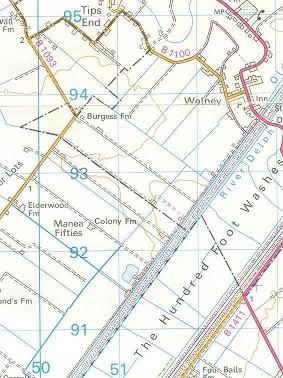
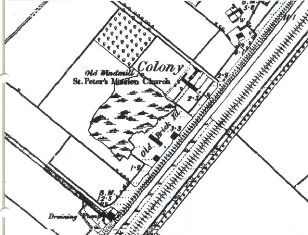
Utopian dream - the founding of The Colony
Owen's ideals prompted one of his followers, William Hodson, a local farmer and one-time sailor and lay Methodist Minister, living at at what was then Brimstone Hill, now Christchurch, to create his own version of a socialist utopian colony in 1838 on 150-200 acres of his own land at Manea Fen, now known as the Manea Fifties.He and his fellow Colonists built a little township against the west side of the Old Bedford River at OS grid ref TL 515920 (ie immediately north-east of the lake shown on the map on left).
The colonists built cottages, heated from a central source, a school, pavilion and windmill, worn a uniform of Lincoln green suits, and produced newsletters, ‘The Working Bee’, which was widely distributed. There were 46 weekly editions from 20th July 1839 to 30th May 1840, the last two having the additional title ‘Herald of the Hodsonian Community Society’.
They also had their own brickyard on the southern edge of the Colony township and adjacent clay-pits . These are shown on the OS map for 1891, as is a mission church, St. Peter's, which is not mentioned in the three academic papers linked above.
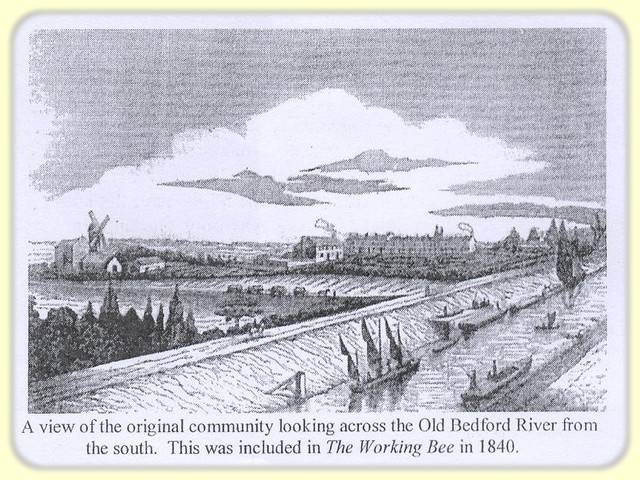 Hodson was a friend of Owenite follower James Hill, a Wisbech banker and corn merchant.
Hill's eighth daughter, appropriately named Octavia, became the founder of
the National Trust.
Hodson was a friend of Owenite follower James Hill, a Wisbech banker and corn merchant.
Hill's eighth daughter, appropriately named Octavia, became the founder of
the National Trust.back to contents
Hard Labour
Today's lake was once a clay-pit (or maybe several pits) from which the original Colonists of 1838-1841 extracted the material for the bricks used in the construction of their houses and communal buildings. Although the Colonists apparently all left the site in the early 1840s, the houses didn't stay empty for long, and digging clay and making bricks continued for many years. The 1851 census showed 15 houses occupied by 74 people (including, presumably, many children). Eleven men were then involved in brick-making. Thirty years later the population was down to 27, only one of whom was a brick-maker, and only 6 houses occupied. There were still people living in some of the old houses in the early 1900s. Records show that a baptism took place at The Colony in early 1906, but I believe the houses were all were vacated shortly after.| Year | Occupied Houses | un-occupied houses | People | surnames | ocupations |
| 1840 | colonists | ||||
| 1841 | 19 | all local families - no colonists, according to Lord | agricultural labourers, farm servants | ||
| 1851 | 15 | ? | 74 | ||
| 1861 | |||||
| 1871 | |||||
| 1881 | 6 | 2 | 27 | ||
| 1891 | 8 | 63 | |||
| 1901 | |||||
| 1906 | |||||
| 1911 | none | none |
Tony Smart's boyhood memories
back to contents1930s - Millionaires playground
The Vandervells
The Lorraines
back to contentsThe Fishing Lake
Pete Young and his mates
Regular visitors to the lake from the 1970s up to 2001 were four friends who lodged in a chalet on the far side of the lake.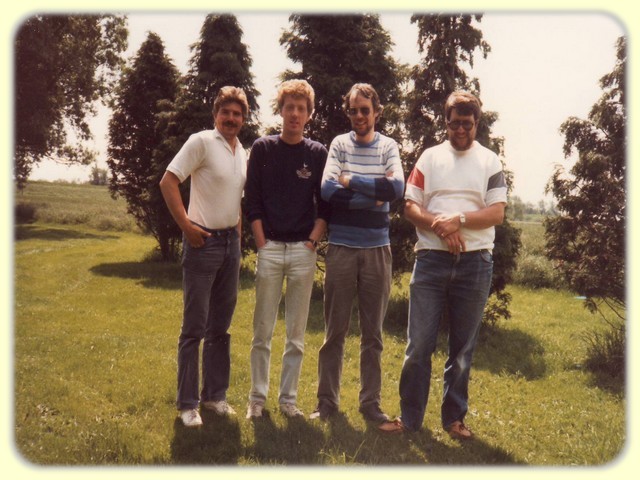
Seen here in 1987, from left to right: Pete Young, Glyn Pemberton, Ian Webb and Mick Highnam. (In 2009, Pete & Mick were living in the Southend area, Glyn near Peterborough and Ian at Feltwell.)
Pete Young e-mailed in 2009:
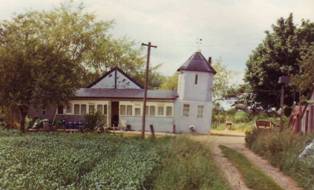
all photos in this section
courtesy of Pete Young. Many more of Pete's photos are on the Slideshow
"I have attached a photo of the original house down at Colony which I took in the 70's. How that tower never fell down I shall never know, I believe it moved a bit every year.
The owners then were Bob & Hilda David who we got to know because they also owned what was then the Pisces Caravan Park & Fishery. In those days the park consisted of just one lake, a chalet, about a dozen caravans and an outside toilet block. After a couple of holidays in one of their caravans we were invited to fish up at their place (Colony) which in those days was a rare privelidge, they seemed to just take a liking to us.
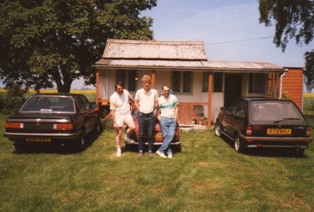
We were then offered a regular week in June staying in the chalet on the other side of the lake. We continued to stay in the chalet every June & the odd long weekend right up till 2000. Bob & Hilda moved out in 1995 selling the property to Bill Whitehouse & his wife who, like us, had been customers of theirs for many years. Bill was also a keen angler who we had met on a number of occasions up there and things didn't really change much. We continued to fish the lake every year but it all changed when he sold up in 2001.
The Crouts were the next owners and wrote to us to say that for the time being they were not having anyone stay up there as they had plans for the place which included doing some work on the lake and the possibilty of some more chalets. Things went onto hold really and the thought of us possibly having to share the lake with other Anglers in the future wasn't that appealing, part of the magic of the place was having it completely to ourselves and the tranquility and peace that existed there. Probably being selfish but it's difficult to find places like that which we regarded as a little piece of paradise with some great fishing thrown in. We didn't hear from the Crout's and the years seemed to come and go, I haven't actully met them but spoke to Abigail on the phone shortly after they moved in. One of our mates who lives in Feltwell has been down there a few times and even fished it again recently, he told us that the railway carriages had finally gone. Maybe I will get to fish it again some time, it's been 9 years now since I cast a rod and line down there, doesn't feel as though it was as long ago as that.
As you know there was a commune down there set up by William Hodson in the 19th century. I believe Bill Whitehouse had some research on it which Bob & Hilda did, I have asked my mate Mick if he still has a contact phone number for him, if so I will let you know. You are right about the place being originally owned by a wealthy family from London. I believe it was the Vandervells who I think were connected to the engineering company which produced bearings. I have heard a few stories of the things that were supposed to have gone on down there back in the 30's, most of which would have probably been told to me in the Tuns. Charles (Chas) Morehen lived down there and was Hilda David's first husband. He died a few years or so before we discovered Welney. He had a heart attack down there and obviously the remoteness of the place didn't help with regards to getting him medical attention, I believe it was around the late 60's. I cant remember how old he was and it's a bit of a grey area as to how he first started to live there, I'm fairly sure he was initially renting the place from the Vandervell's."
Owners and Occupiers
| from | to | owner(s) | occupier(s) | status/remarks | land use |
| pre 1838 | Hodson, William | farmer | arable | ||
| 1838 | 1841 | The Colonists | |||
| 1841 | 1906 | various local families | farm labourers, brickmakers | ||
| Cambs CC | smallholders | holdings foe ex-soldiers | arable | ||
| 1925s? | Vandervell family (trust?) | 8 acre plot with lake & bungalow | |||
| 1925s? | 1967 | Loraine, Lenny | tenant of Vandervell's ? mover to caravan at Three Tuns, Welney |
||
| 1970s | Morehen, Chas & Hilda | owners or managers ? | |||
| 1970s? | 1995 | David, Bob & Hilda | David, Bob & Hilda | Hilda previously married to Morehen. Also owned Pisces |
fishing lake holiday chalet |
| 1995 | 2001 | Whitehouse, Bill & wife | Whitehouse, Bill & wife | ||
| 2001 | to date | Crout, Peter & Abigail | Crout, Peter & Abigail | private, but some fishing | |
back to top of page & contents